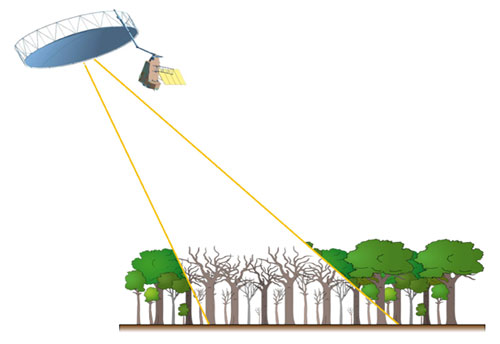- Biomass
- Mission
- Biomass Objectives
Biomass Objectives

The Earth Explorer mission Biomass will provide global maps of the amount of carbon stored in the world's forests and how this changes over time, mainly through absorbing carbon dioxide, which is released from burning fossil fuels.
Forests absorb, store and release large amounts of carbon; therefore, they are a key component of the carbon cycle. Despite this crucial role, forest biomass is poorly quantified in most parts of the world. Responding to this challenge, the Biomass mission will provide measurements of forest above ground biomass and forest height. The global mass of trees is not obtainable by ground measurement techniques, but forest type and forest cover worldwide can be detected by today's satellites and Biomass will take the information to the next level. The satellite's P-band synthetic aperture radar will be able to deliver accurate maps of tropical, temperate and boreal forest biomass.
This urgently-needed data will shed new light on the state of our forests and how they are changing, and, in turn, advance our knowledge of the global carbon cycle. Reliable knowledge of forest biomass also underpins the implementation of the UN Reducing Emissions from Deforestation and forest Degradation (REDD+), initiative – an international effort to reduce carbon emissions from deforestation and land degradation in developing countries.
Observations from this new mission will also lead to better insight into rates of habitat loss and, therefore, the effect this may have on biodiversity in the forest environment.
The Biomass mission will address a fundamental gap in our understanding of the land component of the Earth system, which is the status and the dynamics of Earth's forests, as represented by the distribution of forest biomass and its changes. With accurate, frequent and global information on these forest properties at a spatial scale of 200 m, it will be possible to address a range of critical issues with far-reaching scientific and societal consequences.
In particular, the Biomass mission will help to:
- reduce the large uncertainties in the carbon flux due to changes in land use
- provide scientific support for international treaties, agreements and programmes such as the UN's REDD (Reducing Emissions from Deforestation and Forest Degradation in Developing Countries) programme
- improve understanding and predictions of landscape-scale carbon dynamics
- provide observations to initialise and test the land element of Earth system models
- provide key information for forest resources management and ecosystem services
The Biomass mission will explore Earth's surface for the first time at the P-band wavelength, making observations that could have a wide range of, as yet, unforeseen applications, such as for mapping subsurface geological features in deserts in support of palaeohydrological studies and in ice sheets, and the surface topography of areas covered by dense vegetation.